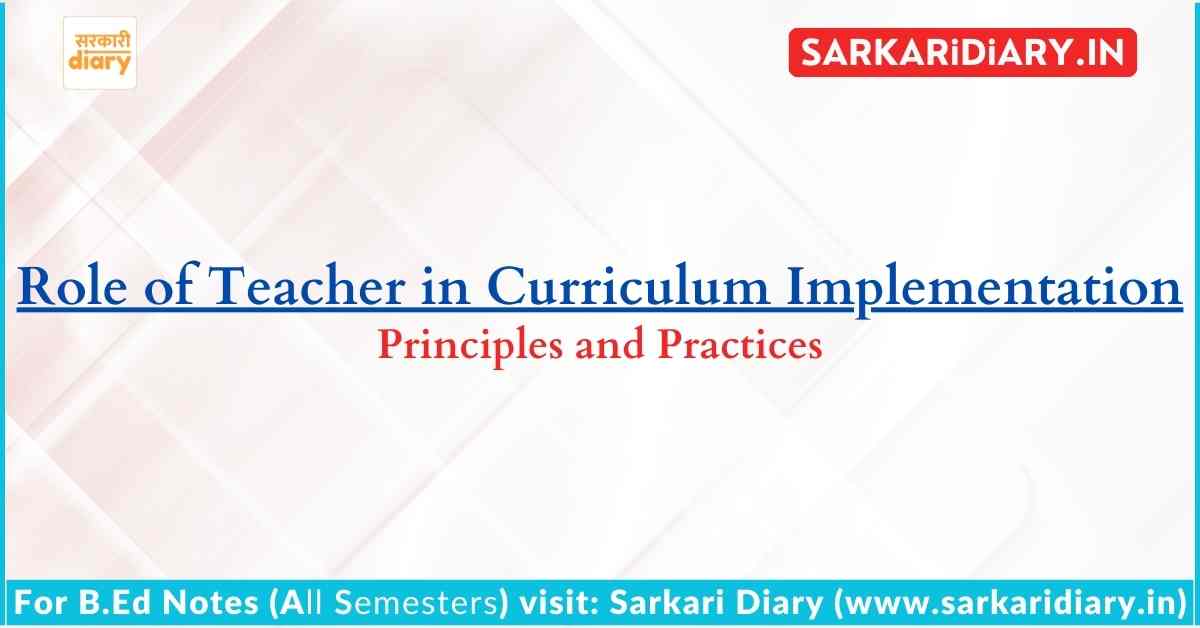In the educational process, the teacher is a central figure—the dynamic link connecting the learner, the curriculum, and the learning environment. Teaching is not simply about passing information; it is about preparing students to face life with the skills, knowledge, and attitudes they need to succeed.
A teacher must understand both the subject and the learner’s psychology to build meaningful relationships that support growth. In curriculum implementation, this relationship becomes even more vital, as the teacher translates curricular goals into classroom reality.

Teacher’s Role in Curriculum Implementation
The teacher acts as a facilitator, guide, motivator, and planner, ensuring that the curriculum is not just taught, but experienced and internalized by students. To do this effectively, teachers follow certain principles of teaching, which are discussed below.
Key Principles of Curriculum Implementation by Teachers
Principle of Activity – Learning by Doing
Modern educational thinkers stress that learning must be active, not passive. This is reflected in approaches like the Project Method, Montessori, Dalton Plan, and Basic Education.
“What has to be done must be learned by practice.” – Comenius
Why It Matters:
- Active learners retain knowledge better.
- Physical activity engages the mind, aiding critical thinking.
- Skills like painting, music, and science experiments are best learned through hands-on practice.
Principle of Motivation – Creating the Desire to Learn
Without motivation, learning is mechanical and uninspired.
“You can take a horse to water, but you can’t make it drink.” – Proverb
Effective teachers:
- Stimulate curiosity.
- Connect content to students’ goals, dreams, and real-life situations.
- Use competition, self-expression, and recognition to engage learners.
Principle of Linking with Life – Education for Real-World Relevance
“Education and life are two aspects of the same fact.” – John Dewey
Education must reflect the real-life needs of students. Learning becomes meaningful when students can relate classroom knowledge to everyday experiences.
Example:
- Teaching fractions using daily shopping examples.
- Using school gardens to teach environmental science or agriculture.
Principle of Interest – Making Learning Enjoyable
Interest drives attention, which in turn boosts retention and understanding.
Effective teachers:
- Begin lessons with stories, questions, or real-life problems to spark curiosity.
- Design activities that align with students’ natural interests.
- Avoid monotonous instruction and embrace interactive, student-centered methods.
Principle of Selection – Choosing What and How to Teach
A successful teacher carefully selects content and methods suited to the needs, age, ability, and psychological readiness of students.
Key Practices:
- Tailoring lessons to suit class level.
- Balancing depth with breadth of topics.
- Integrating audio-visual aids, real-life examples, and cross-disciplinary content.
Principle of Definite Aim – Teaching with Purpose
Every lesson must have a clear objective. Without it, both teacher and learner may lose focus.
“If you don’t know where you’re going, you’ll probably end up somewhere else.” – Yogi Berra
Why It Matters:
- Helps in planning and assessment.
- Focuses learners’ attention.
- Supports goal-based evaluation and feedback.
Teachers must communicate lesson objectives clearly at the beginning of the session to help students understand what they are expected to learn and why.
Teacher as the Bridge Between Curriculum and Students
In curriculum implementation, the teacher is the translator of policy into practice. They:
- Adapt curricular content to match student needs.
- Facilitate classroom activities that promote curriculum goals.
- Assess student learning to ensure curriculum effectiveness.
- Provide feedback to curriculum designers for ongoing improvement.
Impact of an Effective Teacher in Curriculum Implementation
| Role | Outcome |
|---|---|
| Planner | Creates lesson plans aligned with curriculum goals |
| Facilitator | Guides learners using active, participatory methods |
| Assessor | Measures learning outcomes and gives feedback |
| Innovator | Adapts methods to diverse classroom situations |
| Mentor | Inspires students to apply knowledge in real life |
Summary Table: Principles of Effective Curriculum Implementation by Teachers
| Principle | Purpose |
|---|---|
| Activity | Encourages learning by doing |
| Motivation | Sparks interest and commitment to learn |
| Linking with Life | Makes learning relevant to daily life |
| Interest | Ensures student engagement and enthusiasm |
| Selection | Chooses content and methods suitable for learners |
| Definite Aim | Provides clarity and direction in the learning process |
Conclusion
The teacher is not just a deliverer of content, but a transformer of minds. In implementing any curriculum, especially in a diverse and dynamic system like India’s, the human element—embodied by the teacher—is irreplaceable.
By following key educational principles such as activity, motivation, life linkage, interest, selection, and clear objectives, teachers ensure that the curriculum is not only taught but lived by the learners.
“The teacher is the yardstick that measures the achievements and aspirations of the nation.”